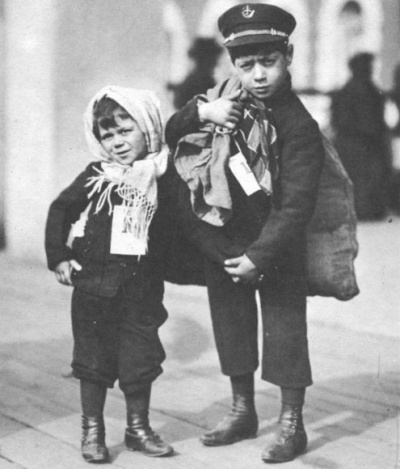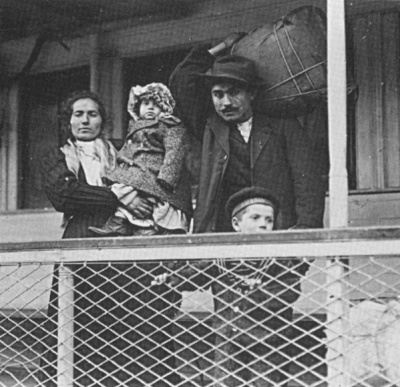From The Peopling of New York City
A World in a Class, a Class in a City
Contents |
Wiki Pages
Introduction
Throughout our display, we will be taking you through the interesting journeys of hypothetical families representing three influential groups of immigrants: the Italian Valentino family, the Irish Callaghan family, and the African-American Senkofa family. Based on the information learned throughout the semester, we will create fictional situations that we believe are accurate representations of the real life stories we studied.
We have traveled throughout New York City to various landmarks allowing us to obtain hands-on knowledge about the ethnicities studied. First, we experienced the iconic location of Ellis Island. A major group that came through this port was the Italians. To represent this vast group, we have created the Valentino family. Arriving from Palermo, Sicily with no money and no home, the Valentino family came only with the hope of the “American Dream.” Upon arrival, the Valentino’s quickly discovered that surviving in America would entail taking a low paying job to support the entire family.
Similar to the Italians, the Irish immigrants came from a distant shore. The Callaghan family faced a problem of their own. They came a long way from Dublin, Ireland. Upon arrival in America, the Callaghan’s faced enormous difficulties finding a place to live. Out of desperation, the Callaghan’s settled in the slums of the Lower East Side Tenements. The conditions were cramped, working plumbing was a rarity, and life expectancy was dangerously low, especially for infants. This held true for their youngest daughter, Kelly. Because of these terrible conditions and consumption of the toxic “swill milk,” she died at the young age of 6 months. This only added to the other problems they and every other immigrant faced in America, a new land. Thomas and Meghan Callaghan, mother and father, kept their heads held high and relied on their Irish pride and determination to overcome these difficulties. The optimistic Irish always looked at things as a positive. They knew times were hard, but in the end the result would be a better future for their children and descendants. The Irish prospered.The Senkofa Family struggled with a vastly different problem than that of the Valentino’s and Callaghan’s. They did not come here of their own volition. They were slaves and were bought by a New York based company and forced to build up the area of Lower Manhattan. Their struggles included a cruel master, the hatred directed at them by other ethnicities, and being reduced to property. They worked and slaved to make Manhattan partially what it is today. The father and mother, Kwame and Keisha, even under the oppression of slavery, managed to give birth to their daughter, Ayana. She grew up living the life of a slave girl and nearly died of starvation. Their horrific plight finally came to an end when the three family members died from consuming poisoned meat. They died in the place where they had the least respect, their master’s land. Their bodies were eventually moved to the African Burial Ground. In this wiki, our class will proceed to discuss each landmark we studied, which symbolize each family’s journey to America. We will use various forms of media, including self-produced videos and photos. Our true goal is to grant the respect that each of these families so fervently sought in life, but never achieved.
Research
The Italians
Foner noted that a tremendous amount of Italians immigrated to the United States. A table by Frank J. Cavaioli proves this fact: Italian Immigration to the United States as Recorded by Country of Birth and Country or Region of Last Residence:1820-2004: FROM PATTERNS OF ITALIAN IMMIGRATION TO THE UNITED STATES BY Frank J.Cavaioli
| 1820: 30 | 1931-1940: 68,028 |
| 1821-1830: 409 | 1941-1950: 57,661 |
| 1831-1840: 2,253 | 1951-1960: 185,491 |
| 1841-1850: 1,870 | 1961-1970: 214,111 |
| 1851-1860: 9,231 | 1971-1980: 129,368 |
| 1861-1870: 11,725 | 1981-1990: 67,254 |
| 1871-1880: 55,759 | 1991-2000: 62,722 |
| 1881-1890: 307,309 | 2001: 3,377 |
| 1891-1900: 651,893 | 2002: 2,837 |
| 1901-1910: 2,045,877 | 2003: 1,904 |
| 1911-1920: 1,109,524 | 2004: 2,495 |
These Italian immigrants have come a long way – back in the early 20th century Italians were at the bottom of every ladder possible, many Americans disliked the Italian culture and the Italian people. However now we see that Italian culture has been immersed in American society – pasta, pizza, mobster movies, and following the Italian soccer team are now staples in American life.
Back in the day an Italian family such as the Molino’s would have had a workman father, a homemaker mother, and kids that were seen to be troublemakers – little respect would be given to such a family and they would often be living in poverty. In fact, wages for Italians would often be less than those of ‘whites’ and the ‘colored’. (Foner 148)
Somewhere along the way though Italians became Americanized – or in other words, they became accepted by society and their culture meshed with American culture. These Italians came to fit the category of ‘white’. Now many Italians are very prosperous the Molino name now could probably be seen on a fancy restaurant and on a mailbox in well-off neighborhoods such as Howard Beach.
As Nancy Foner shows, Italian immigration documents how light-colored ethnic groups such as the Italians and Jews were able to achieve a higher status in society over the years because society came to see these groups as fitting under the umbrella of ‘Caucasian’.


